First Books for Emergent Beginning Readers
by Carol Otis Hurst. This article first appeared in Teaching K-8 Magazine.
We used to think that a child's first books for independent or guided reading should be those with repeated words and short, choppy sentences. Once, when I asked Arnold Lobel why so many characters in his easy-to-read books were neurotic, he said they didn't start out that way, but when you say the same thing over and over again in such brief command sentences, you tend to get neurotic very quickly.
However charming those books by Lobel and a very few other successful authors of the genre were, research by Diane Deford and many others has shown that these books are not easier for new readers to read. In fact they are more difficult and furthermore they lead to the writing of short, choppy sentences by those children. The easiest books for children attempting to make sense of our written language are those in which the language flows in a more natural manner and those in which the action of the text is quite literally interpreted by accompanied pictures. Books where one or more phrases or sentences are repeated in the text in an easily recognized pattern also help new readers notice the conventions of print and make meaning of the text.
With this research accompanied by my own experiences with new learners and teachers of those children in mind, I'd like to highlight a few of these books and explain what factors make them suitable purchases for kindergarten and first grade classrooms in single or multiple copies not as supplementary reading materials but as elemental classroom reading materials. Some of these books will be old chestnuts that you may have been using in the literature program right along although maybe not as first books and others are new finds, for me anyway. Remember that the accent should be on enjoyment and making meaning, not on calling out correct words.
Before we get to spouting book titles, remember that inspiring reading is more than just throwing books at the kids. There's lots of direct teaching involved. While the kids are getting exposure to real books and getting meaning from them, they are also working in groups large and small with you and print materials. All those chants, rhymes and songs that are part of their warm up activities are made into print materials: charts, overhead transparencies, sentence strips, and word games. With your help and help from each other they are noticing the conventions of print, learning to recognize letters, figuring out which words must say what, learning how print comes to have meaning. That's a lot of work on their part and yours but, without it, many children will not be able to read and write with success.
(Continued Below)
Advertisement:
One more thing: a disclaimer. What follows are just a few of the very many good books that are useful for these purposes. If I wrote this same article tomorrow, I'd probably include other titles as more are being produced all the times and I've no doubt forgotten or never knew about many more.
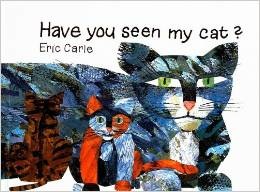
Because of space considerations here, we won't get into the many wonderful wordless books, but do remember that making meaning out of narrative pictures is a good first introduction to reading so make sure you have many of those gems available.
A short step from the wordless books are the repeated question and answer books such as Eric Carle's Have You Seen My Cat? (Find this book: Local Bookstore, Amazon, B&N
).
Nancy Tafuri's Have You Seen My Duckling (Find this book: Local Bookstore, Amazon, B&N
) doesn't have a textual answer, only the title question, leaving the reader to find the duckling and see what else is going on in the pictures.
There are several other good question/answer books but you get the idea. Let's go on to books where the words are slightly more varied but the text/picture connection is similarly literal. Rosie's Walk by Pat Hutchins (Find this book: Local Bookstore, Amazon, B&N
) has been a classroom favorite for years and with good reason. It's a very funny book and there's lots that can be done with it: mapping, dramatizing, retelling the story from the fox's point of view, to name a few. It's also a very good book for beginning readers because each page contains a meaningful phrase, usually a prepositional one and in large print, plus the pictures coordinate exactly with that phrase while providing additional plot. Add it to the list.
(Continued Below)
Advertisement:
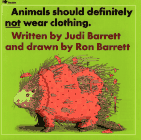
A book of similar ilk is Judi and Ron Barrett's Animals Should Definitely Not Wear Clothing (Find this book: Local Bookstore, Amazon, B&N
). Again we have the large print. Some children don't seem to need it so it's not a prerequisite for early books. For others it helps so a few such books should be in the early readers' library.
Where would predictable books be be if some unknown early author hadn't composed "This Is the House That Jack Built"? That patterned rhyme with its sequentially repeated phrases has been the inspiration for many very good children's books which are a welcome addition to any classroom, especially those full of early learners. These are the books that often drive adults round the bend but they give a recap of the entire plot on each page, making them ideal for some special needs children who have difficulty remembering what's going on here. Mem Fox has used it well in Shoes from Grandpa, illustrated by Patricia Mullins (Find this book: Local Bookstore, Amazon, B&N
). A little girl is outgrowing her clothes and her grandfather says he'll buy her a new pair of shoes. Not to be outdone each relative present at the family barbecue tells what he or she will add to the shoes from grandpa. Each one repeats the items listed so far before adding to it. Try using it with a flannel board and the printed phrases as well as the clothing articles available for manipulation. Do the same for the following book.
Among the easiest of these books is Shirley Neitzel's The Jacket I Wear in the Snow with illustrations by Nancy Winslow Parker (Find this book: Local Bookstore, Amazon, B&N
) uses the "house that Jack built" pattern and combines it with a rebus format to tell the story of too many clothes on one little kid.
Verna Aardema has retold many folktales, mostly from Africa and some fit the "House that Jack Built" patterning. Bringing the Rain to Kapiti Plain with illustrations by Beatrice Vidal (Find this book: Local Bookstore, Amazon, B&N
) is one in which a young boy brings rain to the drought-ridden plain.
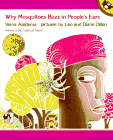
The same author's Why Mosquitoes Buzz in People's Ears with illustrations by Leo & Diane Dillon (Find this book: Local Bookstore, Amazon, B&N
) is a strikingly beautiful book which uses a cumulative text in a pourquois story. with a series of events each based on a misunderstanding.
Don't forget Ed and Barbara Emberley's Drummer Hoff (Find this book: Local Bookstore, Amazon, B&N
) which fits nicely into this category. In it soldiers build a cannon and fire it off whereupon it explodes. Each new participant in the chain of cannon builders is added to the litany on each page which concludes with "Drummer Hoff fired it off."
(Continued Below)
Advertisement:
The Rose In My Garden (Find this book: Local Bookstore, Amazon, B&N
) by Arnold and Anita Lobel is built on the same pattern and has the added advantage of some beautiful descriptive words and a listing of flowers as it tells of a simple incident in a garden.
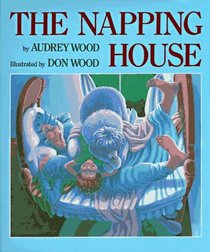
Don and Audrey Wood perhaps topped all the others in this category with The Napping House (Find this book: Local Bookstore, Amazon, B&N
). This one is so well known it seems superfluous to describe it but, in case you've been hiding in remote Nepal, the book describes a cozy bed in a house "where everyone is sleeping". We are shown a room full of creatures both human and animal and, one by one, each climbs on top of the snoring granny on the cozy bed. With each new addition to the pile, we get a repeat of the descriptive phrases so far. There are many subtleties here: the changing color and perspectives, the fact that everybody is there in the first picture, the diminishing sizes, and the fact that it is the smallest of all who causes the collapse. All these make the book appropriate in many classrooms but it'll be appropriated by those newly literate, I think.
Again, those are just a few books with a cumulative pattern. There are many others and they give new readers a running start at reading.
Repeated phrases don't have to be cumulative in the "This Is the House That Jack Built" pattern to make them useful for our purposes. Mem Fox's Hattie and the Fox (Find this book: Local Bookstore, Amazon, B&N
) has text which is strongly patterned and, therefore, predictable.
The repetition in Ruth Brown's A Dark, Dark Tale (Find this book: Local Bookstore, Amazon, B&N
) is limited to the word "dark" but it's repeated twice in every sentence. Here is a funny, pseudo- spooky tale of a dark dark night and a dark dark visitor to a dark dark house. There is a delightful surprise ending. It should be easy to master and fun for new readers to read aloud. And there's the difficult actor's question of how to read those last two words: "a mouse".
Another book with a strongly patterned text is Martin Waddell's Owl Babies illustrated by Patrick Benson (Find this book: Local Bookstore, Amazon, B&N
).
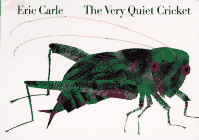
Eric Carle has done several books with a single repeated phrase delivered throughout the book. The Very Quiet Cricket (Find this book: Local Bookstore, Amazon, B&N
), The Grouchy Ladybug (Find this book: Local Bookstore, Amazon
, B&N
) and The Very Busy Spider (Find this book: Local Bookstore, Amazon
, B&N
) are particularly useful for our intended readers because of their strong predictability and repeated phrases.
Leland Jacobs wrote a delightful poem in which the word "goodnight" starts each line in Goodnight Mr. Beetle, published in big book format by SRA/Macmillan. (Find this book: Local Bookstore, Amazon, B&N
).
Chicken Soup with Rice (Find this book: Local Bookstore, Amazon, B&N
) that delightful seasonal classic by Maurice Sendak goes in the early reading pile as well. Sendak's ode to the seasons far precedes the current interest in pattern books, but it certainly fits the criteria.
Thanks, Bill Martin Jr. for delighting children for so many years and for getting the jump on the rest of us about what real reading is. He's given us so many gems it's hard to pick just a few but his Brown Bear, Brown Bear with its delightful illustrations by Eric Carle (Find this book: Local Bookstore, Amazon, B&N
) is outstanding. It begs to be chanted and the pattern is so easily discerned that children often make it their first book to read aloud. It's sequel Polar Bear, Polar Bear (Holt, 1991 ISBN 0 8050 1759 3) is almost as good.
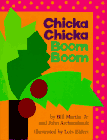
Compare what new readers get from exposure to Bill Martin and John Archambault's Chicka Chicka Boom Boom (Find this book: Local Bookstore, Amazon, B&N
) to what they'd get from filling out endless ditto sheets to help them recognize letters and there's no doubt what the winner will be. Not only do you have the letters as characters with Lois Ehlert's vivid and uncomplicated illustrations to help, you have the repeated chorus, "Chicka Chicka Boom Boom, Will there be enough room." I'd be sure to make charts and sentence strips for the pocket chart from this one. I'd also have lots of replaceable cards for the letters using variations in color, size and style for each.
Besides all these books and others which use repeated phrases to help new readers and writers, there are books that make good starter books because the illustrations and text go so well together that the meaning of each page is clear. Audrey Wood's Silly Sally (Find this book: Local Bookstore, Amazon, B&N
) is a chantable, silly book that meets those standards very well. Remy Charlip's Fortunately (Find this book: Local Bookstore, Amazon
, B&N
) is another.
Years ago, when using literature to teach reading wasn't as prevalent as it is now, I was telling stories to a group of preschoolers and their parents in Pine City, Minnesota. When the storytelling was over, one three year old grabbed my copy of Don and Audrey Wood's The Little Mouse, the Red Ripe Strawberry, and the Big Hungry Bear (Find this book: Local Bookstore, Amazon, B&N
). She said, "Look, Daddy!" and sat right down on the floor and began to read it to him. "Hello, Little Mouse. What are you doing? Oh, I see. Are you going to pick that red, ripe strawberry?" and on she went, reading with expression, turning each page at the appropriate time and not missing a word. He was nonplused. He kept trying to stop her and ask her where she'd seen the book before. Like many good readers, she would not brook any interruption but went right on. Giving up, he turned to me and said very tentatively, "She's not really reading..... is she?" I spent a lot of time explaining that while she probably wouldn't recognize any of those words in any other context, we teachers know that the answer is, "Yes, she is and she's off to a wonderful start." Thanks, dear.
Related Areas of Carol Hurst's Children's Literature Site
- Reading. Curriculum Area with Articles and Professional Books.
- Whole Language
- Book Reviews by Grade Level
- The Very Quiet Cricket by Eric Carle. Teaching Guide with review, activities, related books and links.
- The Very Hungry Caterpillar by Eric Carle. Book Review with related links.

